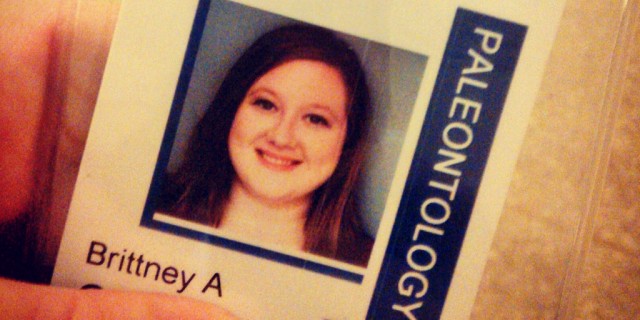Basically spending her summer as Ross Geller, Brittney Oleniacz had the opportunity to intern with the American Museum of Natural History. She got to visit ALL of the exhibits, hold a moon rock and chill with Neil Degrasse Tyson. Excuse us while we geek out a bit. We asked Brittney to tell us all about her intern days.
Hometown: Phillipsburg, NJ
Major: Graduate student in Museum Studies
Internship title and company: Microfossil Intern, American Museum of Natural History (AMNH) in New York City
What were your responsibilities? I interned on a National Science Foundation (NSF) funded project to conserve, photograph, CT scan, and catalogue the microfossil collection. My primary responsibility was to oversee entries into the database and revise the data entry protocols.
What was your favorite part of the internship? The people. AMNH has a wonderful team of dedicated and passionate researchers and staff that I had the opportunity work with on a daily basis. Also, I got to hold a moon rock, see the beak of a giant squid (the largest invertebrate), see the “Big Bone Room” where the dino fossils are stored, see the smallest bird species, and hold rare fossils of wasp burrows. Oh, and drink wine with Neil Degrasse Tyson…and live in the greatest city in the world!
What did you gain from the experience that will be valuable to you in the future? The internship was instrumental in changing my perspective of myself, I began no longer viewing myself as a student, but as a qualified professional. Now that I have applied, been hired and completed the AMNH internship, I know I’m ready to apply for jobs and that I’m a strong candidate.
How did you find out about this internship? In all honestly, I stalked their employment website for about three months.
What advice would you give students who are considering an internship? Set your goals high. My master’s program requires a 250-hour internship and I knew coming in that I wanted to fulfill this requirement at a large, well-respected institution. Seek guidance in creating a resume and talk to people about what kind of questions to expect in the interview. Think of applying for internships as practice for applying for actual jobs.
How did your major and your time at KU prepare you for this internship? Since I’ve been at KU, I’ve been employed by the Biodiversity Institute to digitize their collections. The Biodiversity Institute is among the five largest collections of natural history specimens in the United States and is well-respected in scientific circles around the world. Working for such an institution has allowed me to gain first-hand experience in collection management while utilizing my undergraduate degrees and cultivating my passion for invertebrate paleontology and museum collections.
If it wasn’t for the experience I gained while working at the KU Biodiversity Institute, I’m doubtful I would have been hired at AMNH. In addition, if the internship wasn’t required, I would have never looked for one in the first place.
What do you want to do after graduation? I want to enter the museum workforce as a collection manager in invertebrate paleontology at a reputable institution, and in time pursue a PhD in invertebrate paleontology specializing in taphonomic processes.
